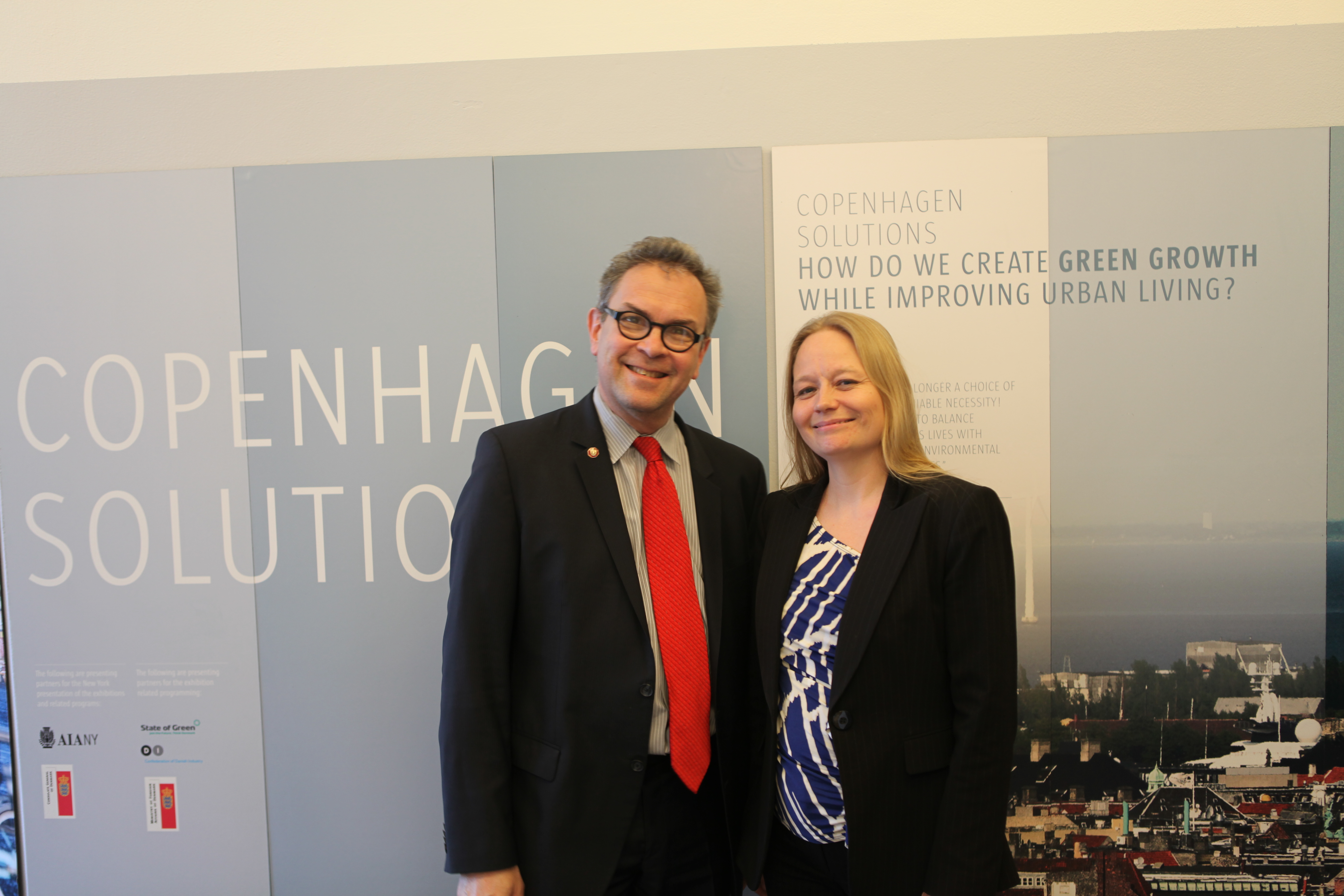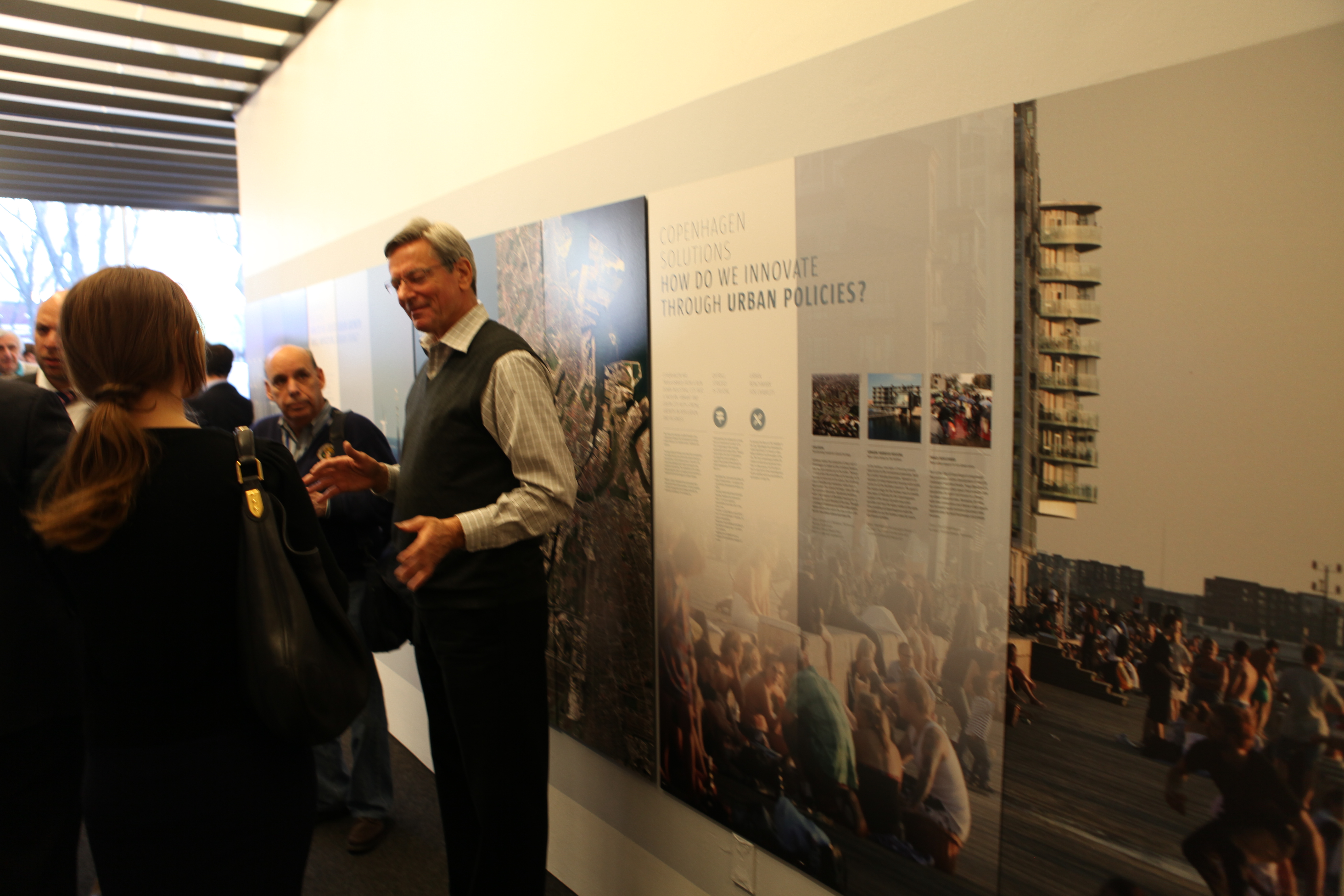by Claire Webb
As the clamoring to address climate change grows louder – just last week, the American Association for the Advancement of Science issued a straightforward, dire warning – it’s striking to compare how cities are either choosing to become greener, or not. Copenhagen has become the model of a city that’s embraced large-scale, civic green design that permeates almost every aspect of public infrastructure.
The Center for Architecture’s exhibition “Copenhagen Solutions” explores how Copenhagen came to be the world’s greenest city, and its plans to become CO2 neutral by 2025. While the city’s success has been mostly localized, it hopes that its model will trigger designs in other cities; because it is the first to take on so much, success can only be improved upon. Singapore and Hamburg, for instance, are capitalizing on Copenhagen’s bold pioneering.
At the exhibition opening, Ambassador Jarl Frijs-Madsen, Consul General of Denmark in New York, talked about how the city’s goal was to improve not just air and water quality, but public life. He reminded us that Danish people are the “happiest in the world” due to these social innovations. He talked about a “civic sprit and vision” that is infused throughout the city.
Kinga Valeria Szabo, general manager of the New York City office of the Confederation of Danish Industries, commented on how she’s witnessed NYC’s rapid changes over the past three years, including adapting to a bike-share program. Having lived in Copenhagen for 15 years, she mused, gives her perspective. She bikes with her child to Manhattan every day for her commute. While the travel is far from perfect, she’s happy that bike lanes have been expanded, and there are more parks and green spaces. She hopes to bring the Danish “know-how” to integrate their solutions here.
The exhibition is anchored around questions that explain the kernels of the city’s solutions. Each solution was punctuated by clear social, economic, and environmental impacts. How do we turn the harbor blue? By modernizing the sewage system; the harbor near Island Brygge was so improved that the public can use a pool that melds with the ocean water. (Check out our very own NYC version, currently in design). How do we connect the city? Through investing in bike lanes and “green waves,” commuters can enjoy uninterrupted travel. The city even designed the routes to be scenic. Even with all the improvements in NYC, I can’t imagine that much priority is being given to cyclists. In Copenhagen, though, the demand is there: 55% use biking as their main transportation, and 80% feel safe. Mass transit, too, is safe and easy; denizens can use the same ticket for metro, bus, and train.
“Copenhagen Solutions” also echoes the global message of the speakers. How do we create green across regions? The city is working with nearby Malmö, Sweden, to share clean tech and even bridge their universities in order to attract engineers to work on clean tech. A new bridge will connect Copenhagen to Hamburg.
The most ambitious goal of the city was expressed by this question: How does Copenhagen become the first CO2 neutral city? The city’s “climate action plan” seeks to engage its citizens to achieve this by 2025. Two micro-projects are ushering in this feat: Nordhavnen, an area that is still a commercial harbor, will function as a kind of laboratory for new green solutions. It will test state-of-the-art cooling, a smart grid, geothermal heating, and solar and wind energy solutions. Splintered into islets and canals, the area will be easily walkable and bikeable. Orstad, established 15 years ago to be a connection to the airport and other urban areas, is bearing the benefits that Nordhavnen promises. Cars are tucked under gardens and the area is very bikeable. The architecture of the Gymnasium responds directly to Danish school reforms of 2005.
In these ways, Copenhagen is global inspiration, but as solving climate change invoked by decades of unsustainable practices, the city really should be the norm. As expressed succinctly in the exhibition, “Sustainability is no longer a choice or a luxury. It’s an undeniable necessity!”
“Copenhagen Solutions” is on view until 04.16.14. And plan to attend the Center’s related program, “Cities by Water,” on 04.08.14.
Claire Webb studied astronomy and philosophy at Vassar College, but an interest in art history and architecture led her to the position of Marketing Director at Edelman Sultan Knox Wood / Architects.
Event: Exhibition Opening | Copenhagen Solutions
Location: Center for Architecture, 03.13.14
Speakers: Rick Bell, FAIA, AIANY Executive Director; Ambassador Jarl Frijs-Madsen, Consul General of Denmark in New York; Kinga Valeria Szabo, general manager of the New York City office of the Confederation of Danish Industries
Organizers: Center for Architecture and the Consulate General of Denmark in New York
Sponsors: City of Copenhagen, Danish Architecture Centre, Realdania (Sponsors), Consulate General of Denmark in New York (Related Programming), The Copenhagen (Catering)





